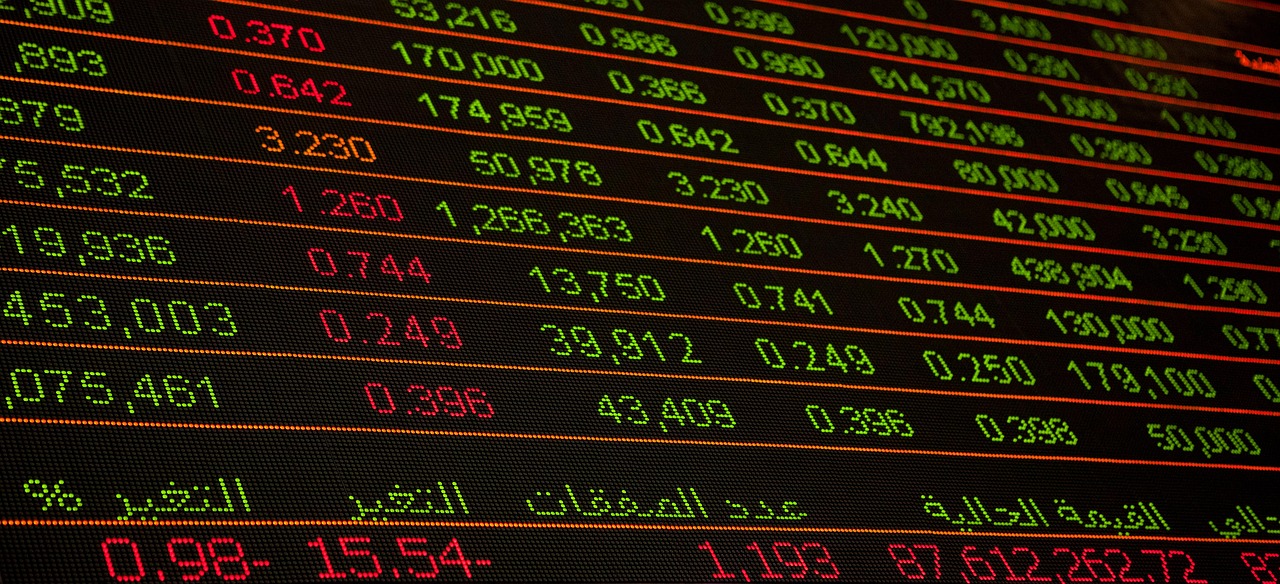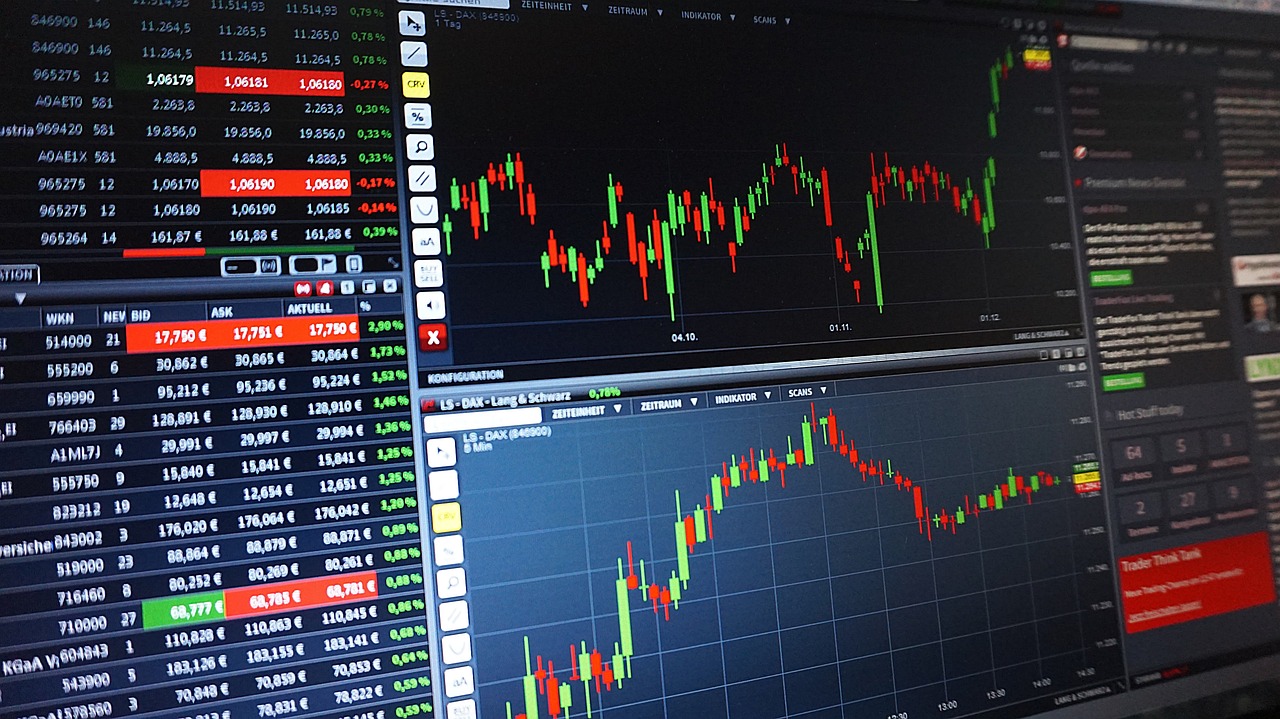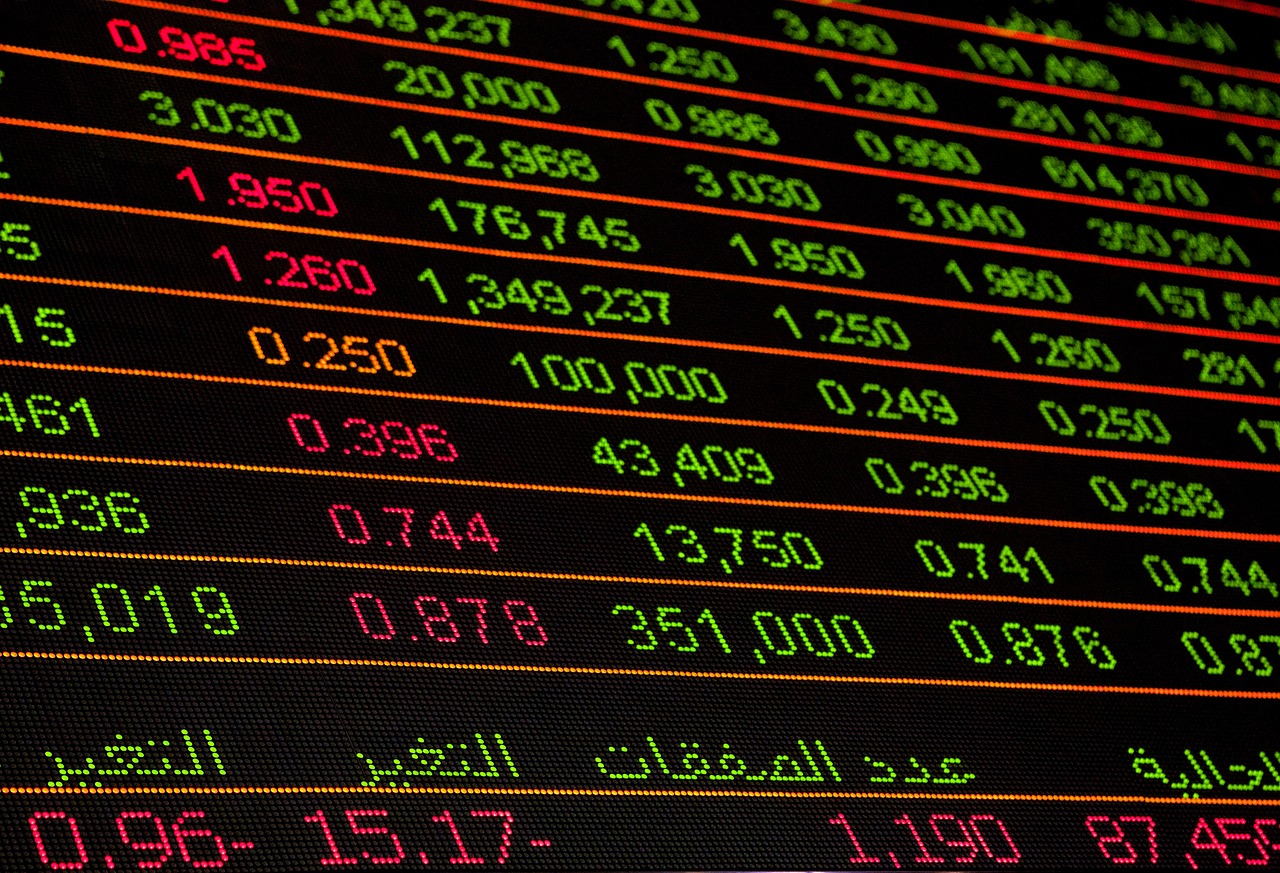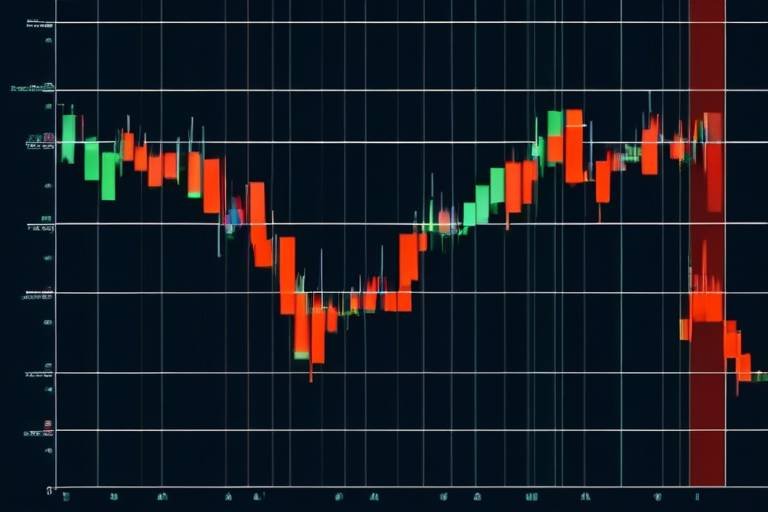How to Trade with the Trend
Trading with the trend is not just a strategy; it's a philosophy that can make or break your success in the financial markets. Imagine standing on a surfboard, waiting for the perfect wave to ride. If you paddle against the tide, you’re likely to wipe out. But when you align with the wave, you can glide effortlessly toward your goals. This article explores effective strategies for trading with market trends, offering insights into identifying trends, utilizing technical analysis, and implementing risk management for successful trading outcomes.
Market trends are the general direction in which prices move. Recognizing these trends is crucial for traders to make informed decisions and capitalize on potential profit opportunities. Think of market trends as the currents of a river; they can vary in strength and direction, and understanding them can help you navigate the waters of trading. Whether you’re a novice or a seasoned trader, grasping the essence of market trends is fundamental to your trading success.
There are three primary types of trends: uptrends, downtrends, and sideways trends. Understanding these categories helps traders determine their trading approach and timing for entering or exiting positions. Each trend type tells a story about market sentiment and potential future movements. By identifying these trends, traders can position themselves to benefit from market fluctuations.
An uptrend is characterized by higher highs and higher lows, indicating bullish market sentiment. In simpler terms, when the price of an asset is consistently climbing, it’s a sign that buyers are in control. Traders often seek to buy during these phases to benefit from rising prices. Just like a plant reaching for the sun, an uptrend signifies growth and opportunity. But how do you spot these uptrends? Let’s dig deeper!
Key indicators of an uptrend include moving averages and higher volume. Moving averages smooth out price data to help traders identify the direction of the trend. Higher volume during price increases suggests strong buying interest, confirming the trend's strength. These signals can guide traders in confirming the strength of the trend before making trades. It’s like having a compass that points you in the right direction, ensuring you’re not just guessing where the market is headed.
Effective strategies during an uptrend include buying on dips and using trailing stops to lock in profits. Buying on dips means purchasing assets when their prices temporarily decline within the overall uptrend, allowing traders to enter at a lower price. Trailing stops, on the other hand, are designed to protect profits by automatically adjusting the stop-loss level as the price rises. These techniques maximize gains while minimizing potential losses, ensuring you ride the wave without getting wiped out.
A downtrend features lower highs and lower lows, reflecting bearish market conditions. Here, sellers dominate the market, and traders typically look for selling opportunities in these scenarios to profit from declining prices. Picture a rollercoaster that’s heading downwards; it’s thrilling but can also be risky if you’re not prepared. Understanding the dynamics of a downtrend is essential for making strategic decisions.
Technical analysis involves studying price charts and indicators to predict future price movements. This approach is essential for traders looking to align their strategies with prevailing market trends. It’s akin to being a detective, piecing together clues to forecast what might happen next. By analyzing patterns and indicators, traders can make informed decisions rather than relying on guesswork.
Popular indicators for trend trading include Moving Averages, MACD (Moving Average Convergence Divergence), and RSI (Relative Strength Index). Each tool provides valuable insights into market momentum and potential reversal points. For instance, while Moving Averages help identify the trend direction, MACD can signal momentum shifts, and RSI can indicate whether an asset is overbought or oversold. Using these indicators in combination can enhance your trading strategy significantly.
Recognizing chart patterns, such as flags and pennants, can enhance trend trading strategies. These patterns often signal continuation or reversal, helping traders make timely decisions. For example, a flag pattern often indicates a brief pause in the trend before it continues in the same direction. By understanding these patterns, traders can better position themselves to take advantage of upcoming price movements.
- What is the best way to identify a trend?
Traders often use moving averages and trend lines to identify trends. Observing price action over time can also provide insights.
- How do I manage risk when trading with the trend?
Implementing stop-loss orders and position sizing can help manage risk effectively while trading with the trend.
- Can I trade against the trend?
While it’s possible, trading against the trend is generally riskier and requires a solid strategy and understanding of market conditions.

Understanding Market Trends
This article explores effective strategies for trading with market trends, offering insights into identifying trends, utilizing technical analysis, and implementing risk management for successful trading outcomes.
Market trends are the general direction in which prices move. Think of them as the currents in the ocean; if you can ride the current, you’ll have a much easier time getting to your destination. Recognizing these trends is crucial for traders to make informed decisions and capitalize on potential profit opportunities. Without a clear understanding of market trends, you might feel like you’re navigating a ship without a compass, lost in a sea of uncertainty.
Trends can be categorized into three main types: uptrends, downtrends, and sideways trends. Each of these trends tells a different story about market sentiment and can significantly influence your trading strategy. Understanding these categories helps traders determine their trading approach and timing for entering or exiting positions.
To put it simply, an uptrend is like climbing a staircase; prices consistently rise, creating higher highs and higher lows. Conversely, a downtrend resembles a downward slope; prices fall, resulting in lower highs and lower lows. Lastly, a sideways trend is akin to running on a treadmill; prices fluctuate within a range without a clear direction. Recognizing where the market is headed can be the difference between making a profit and incurring losses.
In trading, timing is everything. By understanding market trends, you can align your trades with the prevailing market direction. This alignment not only enhances your chances of success but also helps in managing risk effectively. For example, if you’re trading in an uptrend, you might consider entering positions that allow you to ride the wave of rising prices. On the other hand, if the market is in a downtrend, looking for short-selling opportunities could be your best bet.
Furthermore, it’s essential to use various tools and techniques to analyze these trends. Traders often rely on technical analysis to study price movements and identify potential entry and exit points. By combining trend analysis with technical indicators, you can make more informed trading decisions. This holistic approach can help you navigate the complexities of the market with greater confidence.
In summary, understanding market trends is not just about recognizing upward or downward movements; it’s about interpreting the market’s behavior and making strategic decisions based on that interpretation. Whether you’re a novice trader or a seasoned pro, mastering this skill can significantly enhance your trading outcomes.
- What is a market trend? A market trend refers to the general direction in which prices are moving over a certain period.
- How can I identify an uptrend? An uptrend is identified by higher highs and higher lows in price movements.
- What tools can I use to analyze trends? Common tools include moving averages, MACD, and RSI, which help identify market momentum and potential reversals.
- What is the importance of understanding market trends? Understanding market trends helps traders make informed decisions, align their strategies with market movements, and manage risks effectively.

Identifying Trend Types
When it comes to trading, understanding the different types of market trends is like having a map in a vast wilderness. Without it, you could easily get lost or miss out on lucrative opportunities. There are three primary types of trends that every trader should become familiar with: uptrends, downtrends, and sideways trends. Each type has its own characteristics and implications for trading strategies, making it essential to identify them accurately.
Let's break these trends down further. An uptrend is a market condition where prices are consistently moving higher, marked by a series of higher highs and higher lows. Imagine climbing a staircase; each step up represents a new high, while the landings are the lows. In this scenario, traders often look to buy, riding the wave of bullish sentiment that fuels the market's ascent.
On the flip side, a downtrend is just the opposite. Here, prices are on a downward trajectory, characterized by lower highs and lower lows. Picture a downhill slope—each step down signifies a new low, and traders are typically on the lookout for selling opportunities to capitalize on the market's decline. This trend reflects a bearish sentiment, where fear often drives prices down.
Lastly, we have sideways trends, which can be likened to a flat road. Prices fluctuate within a relatively stable range, showing neither strong upward nor downward movement. In this scenario, traders may adopt a more cautious approach, waiting for a breakout in either direction before making their move. It’s during these periods that patience becomes a trader's best friend, as the market can remain stagnant for extended periods.
Understanding these trend types allows traders to tailor their strategies accordingly. For instance, during an uptrend, a trader might consider buying dips to maximize gains, while in a downtrend, short-selling could be the strategy of choice. In sideways markets, traders might employ range trading strategies, buying at support levels and selling at resistance. By recognizing these trends, traders can position themselves more effectively and increase their chances of success.
In summary, identifying trend types is fundamental to developing a robust trading strategy. By familiarizing yourself with the characteristics of uptrends, downtrends, and sideways trends, you can navigate the market more confidently and make informed decisions that align with the prevailing market sentiment.
- What is the best way to identify an uptrend? Look for higher highs and higher lows on the price chart, along with increasing volume.
- How can I tell if a downtrend is reversing? Watch for signs of higher highs and higher lows, as well as key reversal patterns on the chart.
- Are sideways trends good for trading? Yes, they can be profitable if you use range trading strategies effectively.

Uptrends Explained
An uptrend signifies a period in the market where prices are consistently rising, characterized by a series of higher highs and higher lows. Imagine climbing a staircase where each step takes you higher; that’s the essence of an uptrend. This pattern is a clear indication of bullish market sentiment, where buyers are in control, pushing prices upward. For traders, recognizing an uptrend is crucial as it sets the stage for potential profit-making opportunities.
During an uptrend, the market exhibits a certain rhythm that traders can leverage. It’s like riding a wave; if you catch it at the right moment, you can ride it all the way to the shore. But how do you know when to jump on this wave? The key lies in understanding the signals that confirm the trend's strength. For instance, the presence of rising moving averages can be a strong indicator that the uptrend is solid. Additionally, an increase in trading volume often accompanies these price movements, suggesting that more traders are joining the bullish bandwagon.
To further illustrate this, let’s consider a simple table that outlines the characteristics of an uptrend:
| Characteristic | Description |
|---|---|
| Higher Highs | Each peak in price is higher than the previous peak. |
| Higher Lows | Each trough in price is higher than the previous trough. |
| Increased Volume | More traders are buying, indicating strong market interest. |
Now, let’s talk about some effective strategies for trading during an uptrend. One popular approach is to buy on dips. This means waiting for a temporary price drop within the uptrend to enter a position at a lower price, maximizing potential gains. Another useful technique is employing trailing stops. This strategy allows you to lock in profits by adjusting your stop-loss order as the price rises, ensuring that you capture gains while protecting yourself from sudden reversals.
However, it’s essential to remain vigilant. Even in a strong uptrend, the market can be unpredictable. There may be short-term pullbacks or corrections that could test your resolve. This is where risk management comes into play. Always set stop-loss orders to protect your capital and avoid significant losses. Think of it as wearing a seatbelt while driving; it’s a precaution that can save you from a lot of trouble.
In summary, understanding uptrends is vital for any trader looking to navigate the markets effectively. By identifying the signs of an uptrend and employing strategic trading methods, you can position yourself to take advantage of rising prices while managing your risks appropriately. Just remember, every trader’s journey is unique, and what works for one may not work for another. So, keep learning, stay adaptable, and ride those waves with confidence!
- What is an uptrend? An uptrend is a market condition where prices consistently rise, marked by higher highs and higher lows.
- How can I identify an uptrend? Look for higher highs and higher lows on price charts, along with increasing trading volume.
- What strategies should I use during an uptrend? Consider buying on dips and using trailing stops to maximize profits while managing risks.

Recognizing Uptrend Signals
This article explores effective strategies for trading with market trends, offering insights into identifying trends, utilizing technical analysis, and implementing risk management for successful trading outcomes.
Market trends are the general direction in which prices move. Recognizing these trends is crucial for traders to make informed decisions and capitalize on potential profit opportunities.
There are three primary types of trends: uptrends, downtrends, and sideways trends. Understanding these categories helps traders determine their trading approach and timing for entering or exiting positions.
An uptrend is characterized by higher highs and higher lows, indicating bullish market sentiment. Traders often seek to buy during these phases to benefit from rising prices.
When it comes to trading in an uptrend, recognizing the right signals can make all the difference. One of the most reliable indicators is the moving average. This tool smooths out price data to identify the direction of the trend over a specific period. For instance, if the price is consistently above the moving average, it’s a strong sign that the uptrend is intact.
Another key signal to watch for is increased trading volume. When the price rises alongside a surge in volume, it often suggests that the trend is gaining momentum. Think of it like a wave building up before crashing onto the shore; the more volume you see, the more powerful the wave of buying pressure becomes.
Additionally, traders should keep an eye on higher highs and higher lows. This pattern not only confirms the presence of an uptrend but also provides an excellent opportunity for traders to enter the market at strategic points. For example, if you spot a higher low forming, it could be a good time to buy, anticipating that the trend will continue to push prices upward.
To summarize, here are some crucial signals for recognizing an uptrend:
- Moving Averages: Price consistently above the moving average line.
- Volume: Increased volume accompanying price rises.
- Price Patterns: Formation of higher highs and higher lows.
Effective strategies during an uptrend include buying on dips and using trailing stops to lock in profits. These techniques maximize gains while minimizing potential losses.
A downtrend features lower highs and lower lows, reflecting bearish market conditions. Traders typically look for selling opportunities in these scenarios to profit from declining prices.
Technical analysis involves studying price charts and indicators to predict future price movements. This approach is essential for traders looking to align their strategies with prevailing market trends.
Popular indicators for trend trading include Moving Averages, MACD, and RSI. Each tool provides valuable insights into market momentum and potential reversal points.
Recognizing chart patterns, such as flags and pennants, can enhance trend trading strategies. These patterns often signal continuation or reversal, helping traders make timely decisions.
Q: What is the best way to identify an uptrend?
A: The best way to identify an uptrend is by looking for higher highs and higher lows, along with confirming indicators like moving averages and volume.
Q: How can I manage risk while trading with the trend?
A: You can manage risk by setting stop-loss orders and using trailing stops to secure profits as the trend progresses.
Q: Is it always profitable to trade with the trend?
A: While trading with the trend increases the chances of success, it’s important to conduct thorough analysis and manage risks properly to maximize profitability.

Strategies for Uptrend Trading
When it comes to trading in an uptrend, having a solid strategy can make all the difference between riding the wave of profits and getting caught in a downturn. One of the most effective strategies is to buy on dips. This means that instead of jumping in at the peak, savvy traders wait for a slight pullback in the price before making their purchase. Think of it like shopping during a sale; you want to snag the best deal possible, and buying on dips allows you to do just that.
Another key strategy is employing trailing stops. This technique is like having a safety net. As the price of your asset rises, you adjust your stop-loss order upwards. This way, if the price suddenly drops, you can still secure your profits. It's a great way to keep your gains while allowing your investment the room to grow. Imagine you're climbing a mountain; you want to keep climbing higher but also need to ensure you have a way to safely descend if the weather changes.
Moreover, utilizing technical indicators can significantly enhance your trading strategy. For instance, the Moving Average Convergence Divergence (MACD) can help you identify the momentum of the trend. When the MACD line crosses above the signal line, it could indicate a strong uptrend, making it a prime time to enter a trade. Similarly, the Relative Strength Index (RSI) can help you determine whether an asset is overbought or oversold. An RSI below 30 typically suggests that an asset is oversold, presenting a potential buying opportunity.
To illustrate these strategies, consider the following table that summarizes various techniques for trading in an uptrend:
| Strategy | Description | Benefits |
|---|---|---|
| Buy on Dips | Purchase assets during price pullbacks. | Allows for better entry points and maximizes potential profits. |
| Trailing Stops | Adjust stop-loss orders as price rises. | Secures profits while allowing for further price increases. |
| Technical Indicators | Use tools like MACD and RSI to inform trading decisions. | Provides data-driven insights into market momentum and potential reversals. |
Lastly, always remember that risk management is crucial. No matter how confident you feel about an uptrend, market conditions can change on a dime. Setting clear profit targets and stop-loss levels can help you minimize potential losses and protect your capital. Think of it as wearing a seatbelt in a car; it’s a simple step that can save you from significant harm.

Downtrends Explained
A downtrend is a market condition that signifies a general decline in the price of an asset over time. Picture a rollercoaster that’s headed straight down; that’s the essence of a downtrend. It’s characterized by a series of lower highs and lower lows, which can often feel like a relentless wave crashing down, leaving traders scrambling for safety. Understanding this phenomenon is vital for anyone looking to navigate the turbulent waters of trading effectively.
When you observe a downtrend, it’s crucial to recognize the signs early. The market sentiment during these phases is typically bearish, meaning that traders are more inclined to sell than buy. This can create a challenging environment for those who are not prepared. But don’t fret! With the right strategies and a keen eye, traders can still find opportunities to profit even in these gloomy conditions.
Here are some essential characteristics of downtrends that every trader should keep in mind:
- Lower Highs: In a downtrend, each peak is lower than the previous one, indicating a lack of buying pressure.
- Lower Lows: Similarly, each trough is lower than the last, showcasing a consistent decline in price.
- Volume Trends: Often, downtrends are accompanied by increasing trading volume, signaling strong selling interest.
Recognizing these patterns can provide traders with valuable insights into when to enter or exit trades. For instance, if you spot a lower high followed by a lower low, it could be a signal to consider short-selling the asset. However, caution is key; just because the trend is downward doesn’t mean every moment is ripe for selling. Timing your entries and exits is essential, and this is where technical analysis can play a pivotal role.
Moreover, it’s important to note that downtrends don’t last forever. The market is cyclical, and just as the sun sets, it will rise again. Traders should always be prepared for reversals and look for signs of potential trend changes. Indicators such as the Relative Strength Index (RSI) can help signal when an asset might be oversold and due for a bounce back. Think of it as a rubber band stretched too far; eventually, it will snap back, often leading to a reversal.
In summary, downtrends can be daunting, but with a solid understanding of their mechanics and the right strategies, traders can turn these downward spirals into profitable opportunities. It’s all about maintaining a clear head, being observant, and adapting your tactics to the ever-changing market landscape.
Q: What is a downtrend?
A downtrend is characterized by a series of lower highs and lower lows, indicating a bearish market sentiment.
Q: How can I identify a downtrend?
Look for consistent lower highs and lower lows on price charts, along with increasing trading volume.
Q: Can I profit from downtrends?
Yes! Traders can look for selling opportunities or short-selling strategies to capitalize on declining prices.
Q: What indicators are useful for downtrend trading?
Popular indicators include Moving Averages, MACD, and RSI, which can help identify momentum and potential reversals.

Utilizing Technical Analysis
Technical analysis is the backbone of successful trading strategies, allowing traders to forecast future price movements based on historical data. Imagine trying to navigate a vast ocean without a compass; that's what trading without technical analysis feels like. By studying price charts and various market indicators, traders can gain insights into market dynamics and make informed decisions. This approach empowers traders to align their strategies with prevailing market trends, increasing their chances of success.
At its core, technical analysis revolves around the concept of market psychology. Traders react to news, events, and price movements, creating patterns that can be analyzed. By examining these patterns, traders can identify potential entry and exit points. It's like reading a book where each price movement tells a story about the market's sentiment and direction.
One of the most popular tools in technical analysis is the Moving Average. This indicator smooths out price data over a specified period, helping traders identify the overall direction of the trend. For instance, a 50-day moving average can show whether a stock is generally trending upward or downward. When the price crosses above the moving average, it may signal a buying opportunity, while a drop below can indicate a sell signal. This simple yet effective tool is crucial for trend traders who want to capitalize on market movements.
Another vital indicator is the MACD (Moving Average Convergence Divergence). This tool helps traders spot changes in momentum by comparing two moving averages. When the MACD line crosses above the signal line, it can suggest a bullish trend, while a cross below may indicate a bearish trend. The beauty of MACD lies in its ability to provide clear signals, making it easier for traders to make timely decisions.
Additionally, the Relative Strength Index (RSI) is a powerful momentum oscillator that measures the speed and change of price movements. It ranges from 0 to 100, with readings above 70 indicating overbought conditions and below 30 suggesting oversold conditions. Traders often use RSI to identify potential reversal points, making it an essential component of any technical analysis toolkit.
To further enhance your technical analysis, recognizing chart patterns is crucial. Patterns such as flags, pennants, and head and shoulders can provide valuable insights into potential future price movements. For instance, a flag pattern typically indicates a continuation of the current trend, while a head and shoulders pattern can signal a reversal. Understanding these patterns allows traders to anticipate market behavior and adjust their strategies accordingly.
In summary, utilizing technical analysis is not just about crunching numbers; it’s about understanding the market's heartbeat. By mastering key indicators like Moving Averages, MACD, and RSI, along with recognizing chart patterns, traders can navigate the complex waters of trading with confidence. Just like a seasoned sailor reads the winds and tides, a skilled trader interprets market signals to chart a successful course.
- What is technical analysis?
Technical analysis is the study of past market data, primarily price and volume, to forecast future price movements. - How can I start using technical analysis?
Begin by learning about key indicators and how to read price charts. Practice analyzing different assets to build your skills. - Are there any risks associated with technical analysis?
Yes, while technical analysis can provide insights, it is not foolproof. Market conditions can change rapidly, so it's essential to combine it with risk management strategies. - Can I use technical analysis for all types of trading?
Technical analysis can be applied to various trading styles, including day trading, swing trading, and long-term investing.

Key Indicators for Trend Trading
This article explores effective strategies for trading with market trends, offering insights into identifying trends, utilizing technical analysis, and implementing risk management for successful trading outcomes.
Market trends are the general direction in which prices move. Recognizing these trends is crucial for traders to make informed decisions and capitalize on potential profit opportunities.
There are three primary types of trends: uptrends, downtrends, and sideways trends. Understanding these categories helps traders determine their trading approach and timing for entering or exiting positions.
An uptrend is characterized by higher highs and higher lows, indicating bullish market sentiment. Traders often seek to buy during these phases to benefit from rising prices.
Key indicators of an uptrend include moving averages and higher volume. These signals can guide traders in confirming the strength of the trend before making trades.
Effective strategies during an uptrend include buying on dips and using trailing stops to lock in profits. These techniques maximize gains while minimizing potential losses.
A downtrend features lower highs and lower lows, reflecting bearish market conditions. Traders typically look for selling opportunities in these scenarios to profit from declining prices.
Technical analysis involves studying price charts and indicators to predict future price movements. This approach is essential for traders looking to align their strategies with prevailing market trends.
When it comes to trend trading, understanding the right indicators can be your secret weapon. Think of these indicators as the compass that guides you through the often turbulent waters of the market. Here are some of the most popular indicators that traders rely on:
- Moving Averages (MA): These are essential for smoothing out price data over a specific period, helping traders identify the direction of the trend. A common strategy is to look for crossovers, where a short-term moving average crosses above or below a long-term moving average, signaling potential buy or sell opportunities.
- Moving Average Convergence Divergence (MACD): This indicator helps traders spot changes in the strength, direction, momentum, and duration of a trend. The MACD consists of two moving averages and a histogram, providing clear signals when the lines cross.
- Relative Strength Index (RSI): The RSI measures the speed and change of price movements, helping traders identify overbought or oversold conditions. An RSI above 70 may indicate that an asset is overbought, while below 30 could signal that it is oversold.
By incorporating these indicators into your trading strategy, you can enhance your ability to make informed decisions. However, remember that no single indicator is foolproof. It's always best to use a combination of tools to confirm your analysis. For example, if the MACD is showing a bullish signal, but the RSI indicates overbought conditions, it may be wise to proceed with caution.
Recognizing chart patterns, such as flags and pennants, can enhance trend trading strategies. These patterns often signal continuation or reversal, helping traders make timely decisions.
- What is a trend in trading? A trend in trading refers to the general direction in which the price of an asset is moving, which can be upward, downward, or sideways.
- How do I identify a trend? Traders can identify trends using various indicators like moving averages, MACD, and RSI, as well as by analyzing price charts for patterns.
- What is the best indicator for trend trading? There is no single best indicator; however, moving averages, MACD, and RSI are widely used to help traders identify and confirm trends.
- Can I trade without indicators? Yes, some traders rely on price action and chart patterns without indicators, but using indicators can provide additional confirmation of trends.

Chart Patterns and Trends
This article explores effective strategies for trading with market trends, offering insights into identifying trends, utilizing technical analysis, and implementing risk management for successful trading outcomes.
Market trends are the general direction in which prices move. Recognizing these trends is crucial for traders to make informed decisions and capitalize on potential profit opportunities.
There are three primary types of trends: uptrends, downtrends, and sideways trends. Understanding these categories helps traders determine their trading approach and timing for entering or exiting positions.
An uptrend is characterized by higher highs and higher lows, indicating bullish market sentiment. Traders often seek to buy during these phases to benefit from rising prices.
Key indicators of an uptrend include moving averages and higher volume. These signals can guide traders in confirming the strength of the trend before making trades.
Effective strategies during an uptrend include buying on dips and using trailing stops to lock in profits. These techniques maximize gains while minimizing potential losses.
A downtrend features lower highs and lower lows, reflecting bearish market conditions. Traders typically look for selling opportunities in these scenarios to profit from declining prices.
Technical analysis involves studying price charts and indicators to predict future price movements. This approach is essential for traders looking to align their strategies with prevailing market trends.
Popular indicators for trend trading include Moving Averages, MACD, and RSI. Each tool provides valuable insights into market momentum and potential reversal points.
Recognizing chart patterns is like having a secret map in the world of trading. These patterns, which can resemble flags, triangles, or head and shoulders, often provide critical clues about future price movements. For instance, a flag pattern typically indicates a continuation of the current trend, while a head and shoulders pattern may signal a reversal. By understanding these patterns, traders can position themselves advantageously, potentially increasing their profitability.
To effectively utilize chart patterns, it's essential to combine them with other indicators. For example, a bullish flag pattern confirmed by increasing volume can be a strong signal to enter a trade. On the flip side, a bearish head and shoulders pattern might trigger a trader to exit their position or even short the market. This synergy between patterns and indicators is where the magic happens in trading.
Moreover, the context in which these patterns appear is just as crucial. Patterns that form at key support or resistance levels can carry more weight. Thus, traders should not only look at the pattern itself but also consider the broader market landscape. This holistic approach can significantly enhance trading decisions.
In summary, chart patterns are invaluable tools in a trader's arsenal. By mastering the art of pattern recognition and integrating them with other technical analysis tools, traders can enhance their ability to predict market movements and make informed trading decisions.
- What is the significance of chart patterns in trading?
Chart patterns help traders identify potential market movements, providing insights into when to enter or exit trades.
- How can I improve my pattern recognition skills?
Practice is key! Regularly analyze charts and backtest your findings to enhance your understanding of different patterns.
- Are there any specific patterns I should focus on as a beginner?
Start with common patterns like flags, triangles, and head and shoulders, as they are frequently observed and easier to identify.
Frequently Asked Questions
- What is a market trend?
A market trend refers to the general direction in which the price of an asset is moving. Understanding whether the trend is upward, downward, or sideways is essential for traders to make informed decisions and optimize their trading strategies.
- How can I identify an uptrend?
An uptrend is characterized by a series of higher highs and higher lows. Traders can identify an uptrend by looking for consistent price increases over time, often supported by indicators such as moving averages and increased trading volume.
- What are some strategies for trading during an uptrend?
During an uptrend, traders often use strategies like buying on dips, which involves purchasing when prices temporarily fall within the trend. Additionally, implementing trailing stops can help lock in profits while allowing for potential further gains.
- What defines a downtrend?
A downtrend is marked by lower highs and lower lows, indicating bearish market conditions. In this scenario, traders typically look for opportunities to sell or short the asset to profit from declining prices.
- What is technical analysis?
Technical analysis is the study of price charts and various indicators to forecast future price movements. This approach is crucial for traders aiming to align their strategies with existing market trends, enhancing their potential for success.
- Which indicators are essential for trend trading?
Some popular indicators for trend trading include Moving Averages, MACD (Moving Average Convergence Divergence), and RSI (Relative Strength Index). Each of these tools provides valuable insights into market momentum and helps identify potential reversal points.
- How can chart patterns aid in trend trading?
Chart patterns, such as flags and pennants, can significantly enhance trend trading strategies. Recognizing these patterns can signal whether a trend is likely to continue or reverse, allowing traders to make timely and informed decisions.



















